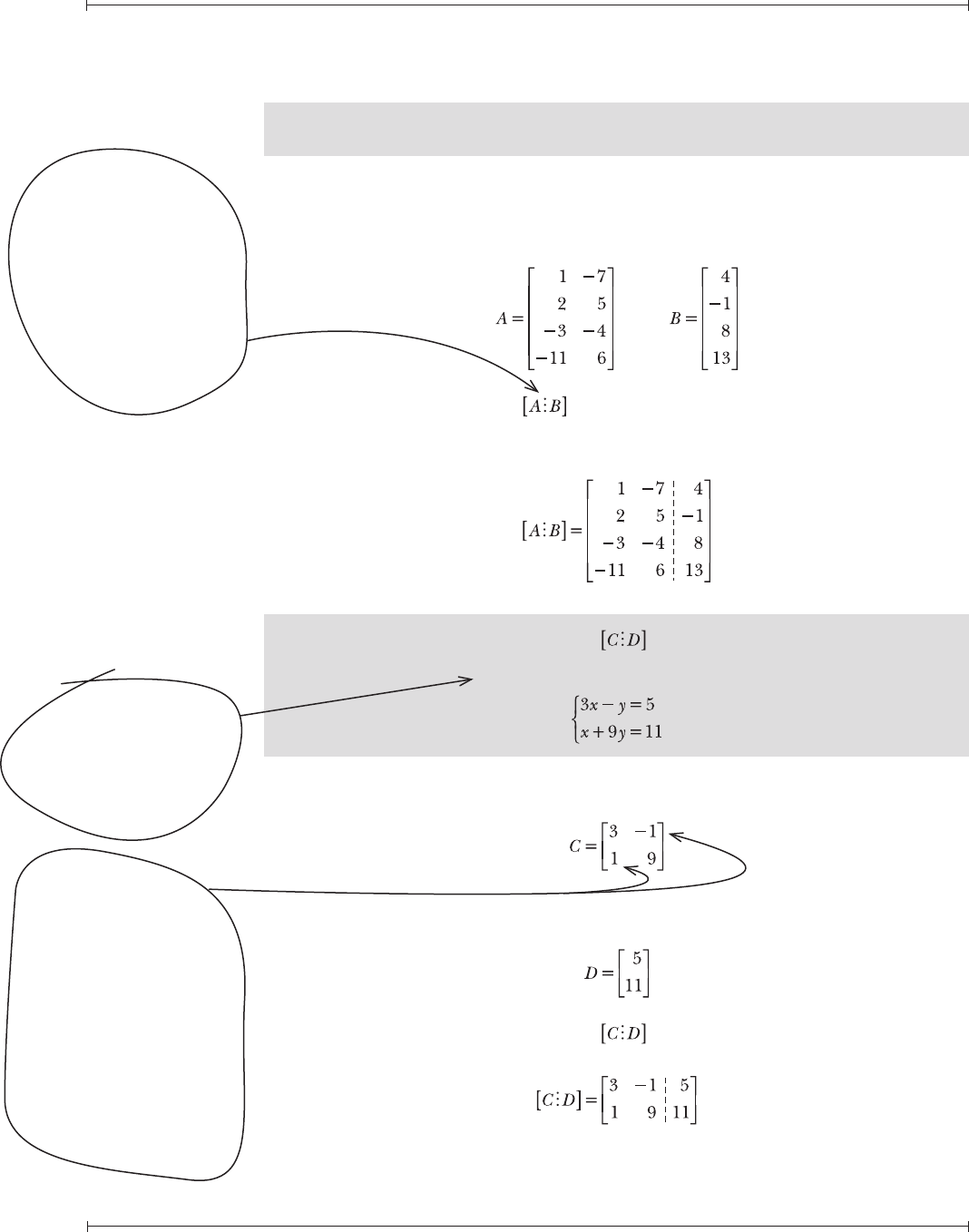
Chapter Ten — Applications of Matrix Algebra
The Humongous Book of Algebra Problems
208
Augmented and Identity Matrices
Extra columns and lots of 0s and 1s
10.1 What is an augmented matrix?
An augmented matrix is created by joining together matrices that contain the
same number of rows. They are most commonly used to represent systems of
equations, whereby the coefficient matrix is joined with a column of constants.
Consider matrices A and B defined below.
The augmented matrix is constructed by including the values of matrix B
as an additional column of matrix A. The new column is usually separated from
the original columns of A by a dotted line.
10.2 Construct the augmented matrix for the below system of equations,
such that C is the coefficient matrix and D is the column of constants.
The coefficient matrix for this system contains the x-coefficients in the first
column and the y-coefficients in the second.
The column of constants is a 2 × 1 matrix containing the numbers that appear
right of the equal sign.
Construct the augmented matrix by including the elements of D as the
third column of C.
You can
also indicate an
augmented matrix
using a solid, instead
of a dotted, line in the
matrix name [A|B] and
in the matrix itself.
Not sure what a
coefcient matrix or
a column of constants
is? Check out
Problem 9.38.
When a term
has no explicit
coefcient written
(like x in the equation
x + 9y = 11, the
coefcient is 1. When
there’s no coefcient
but the variable is
negative (like –y in
3x – y = 5), the
coefcient is –1.

Chapter Ten — Applications of Matrix Algebra
The Humongous Book of Algebra Problems
209
Note: Problems 10.3–10.5 refer to matrix A defined below.
10.3 Construct matrix B that serves as the additive identity for matrix A and verify
that A + B = A.
As explained in Problem 1.36, the additive identity for real numbers is 0.
Adding 0 to any real number x does not change the value of x.
x + 0 = 0 + x = x
To add matrix B to matrix A without changing the elements of A, every element
of B must be 0. Therefore, the additive identity for any m × n matrix is the zero
matrix 0
m × n
.
Verify that B is the additive inverse by demonstrating that A + B = A.
Note: Problems 10.3–10.5 refer to matrix A defined below.
10.4 Construct matrix C that serves as the multiplicative identity for matrix A.
The identity matrix I
n
is a square matrix with n rows and n columns that
contains 0s for each of its elements except for those along the diagonal that
begins with the element in the first row and the first column.
In this problem, matrix A has two columns, so for the product A · C to exist, C
must have two rows. Therefore, the correct identity matrix is C = I
2
.
A zero
matrix is
exactly what
you’d imagine:
a matrix that
contains nothing but
zeros. It has to have
the same dimensions
of A because
you can’t add
matrices unless
they’re the
same size.
An identity
matrix has ones
along the diagonal
that stretches from the
top-left to the bottom-
right corner. All the
other elements in
the matrix are
zeros.

Chapter Ten — Applications of Matrix Algebra
The Humongous Book of Algebra Problems
210
Note: Problems 10.3–10.5 refer to matrix A defined below.
10.5 Verify that A · C = A.
According to Problem 10.4, the multiplicative identity is . Calculate
the product of A and C using the technique described in Problems 9.17–9.19.
Note: Problems 10.6–10.7 refer to matrix B defined below.
10.6 Construct matrix D that serves as the multiplicative identity for matrix B.
Matrix B contains three columns, so the identity matrix must contain the same
number of rows: D = I
3
.
I
3
, like the
identity matrix
I
2
from Problem
10.4, has all zero
elements except
along the diagonal
that goes from top-
left to bottom-right.
The elements in
that diagonal
are all ones.
..................Content has been hidden....................
You can't read the all page of ebook, please click here login for view all page.
